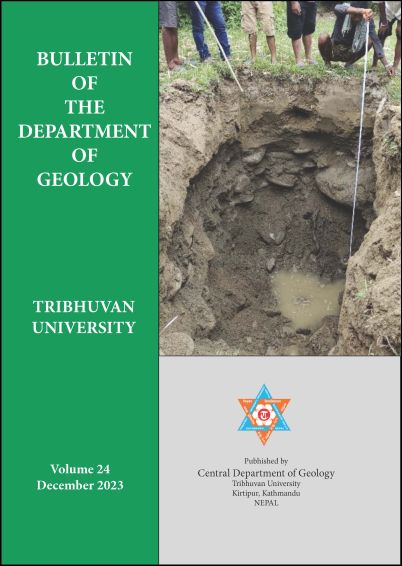Study on Rock Characteristics for Assessing the Hydraulic Erodibility of Sandstones in the Manahari River Section, Sub-Himalaya, Central Nepal
DOI:
https://doi.org/10.3126/bdg.v24i.68374Keywords:
Erodibility, Stream Power, sandstone, Hydraulic Erodibility Index, SiwalikAbstract
The long-term erosion of the bed rock is steered by the power of the stream of variable magnitude and frequency which would give us the idea about bed rock incision and its channel morphology. Large numbers of infrastructural development work such as roads, bridges are undergoing in the Manahari Area. Hence, hydraulic erosion of the rocks is always a topic of interest while carrying out these construction works. Therefore, the main aim of this study is to determine the hydraulic erodibility of the Siwalik rocks under the action of stream power. Erodibility of the rocks and the stream powers of the Manahari River were determined by extensive field survey and laboratory analysis of rock material properties. Rock mass strength, block particle size, discontinuity/inter-particle bond shear strength, the shape of materials units, and their orientation relative to the flow were assessed to determine erodibility of the rocks. The longitudinal and cross-sectional surveys were carried out to find out the hydraulic parameters to calculate the erosive power of the stream i.e., slope of the channel surface, hydraulic radius, and velocity. The erodibility index ranges from 22 to 198 on the basis of their rock mass properties whereas the stream power value ranges from 1 to 6 kW/m2. The value of the stream power obtained at the bankfull condition at different flow time intervals i.e., 10, 25, 50, and 100 years ranges from 5 to 25 kW/m2. With this range of stream power at different time interval flow, the Manahara River has the capacity to erode maximum of the sandstones present in the riverbed as all the values of the erodibility plot above the threshold line of erosion. However, the relation between the erodibility index and stream power at normal flow condition shows that the Siwalik sandstones of the study area are not erodible under the influence of the available stream power.
Downloads
Downloads
Published
How to Cite
Issue
Section
License
© Central Department of Geology, Tribhuvan University, Nepal

